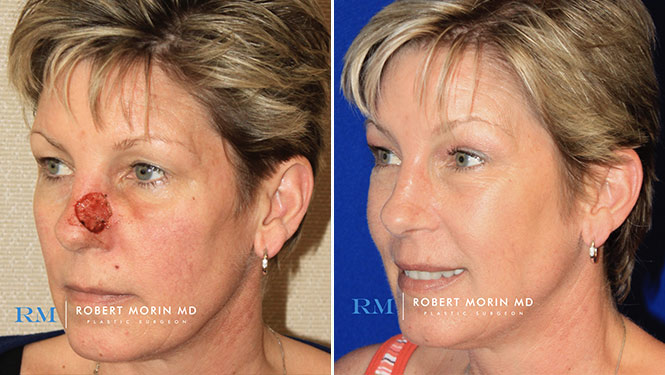
Dr. Robert Morin is a globally recognized teacher, leader and innovator in the field of nasal reconstruction surgery and rhinoplasty. In addition, he is the founder of a non-profit that helps correct nasal and facial deformities involving children living in developing countries around the world. As a leading complex nasal reconstruction specialist, Dr. Morin works closely with dermatologists, surgical oncologists, ENT surgeons, trauma surgeons and neurosurgeons to help patients with complex nasal problems right here in New Jersey as well.

Complex nose reconstruction surgery is a delicate and difficult series of procedures that requires specific training and skills, in addition to detailed knowledge and understanding of the three-dimensional nasal anatomy. In many cases involving severe trauma, skin cancer resection and congenital deformities, it is necessary to restore both the internal framework and external lining of the nose. Nasal injuries often result in permanent structural damage and can greatly affect both the appearance and function of the face. Nasal reconstruction, also referred to as nose reconstructive surgery or reconstructive rhinoplasty, addresses concerns involving nasal airway function in addition to the aesthetic appearance of the nose. Individuals with aesthetic and/or breathing concerns related to trauma, cocaine use, cleft lip nasal deformities, unsuccessful previous nose surgery or skin cancer removal, can potentially benefit greatly from nasal reconstruction performed by Dr. Morin.
As a board-certified plastic surgeon and craniofacial surgeon, Dr. Morin leverages many years of sub-specialty training, surgical experience and compassionate care to successfully restore form, function and integrity to the intricate nasal architecture. New Jersey plastic surgeon, Dr. Morin uses the most advanced rhinoplasty techniques, including the Piezo ultrasound rhinoplasty device, in order to customize each nasal reconstruction surgery and to create both a natural and aesthetically pleasing nose.

*Results may vary
Dr. Morin frequently performs complex reconstructive nose surgeries for patients who have lost nasal skin, nasal cartilage and even nasal bone as a result of cancer or trauma. In addition, Dr. Morin performs complex revision rhinoplasty for clients who have had unsuccessful prior nose surgery and now have a collapsed, or “over-done” nose. He has dedicated most of his career to the detailed study of the nose and face, offering an unparalleled level of skill to his many satisfied patients. Committed to excellence, his goal is to reconstruct both the external appearance and the internal function of the nose while prioritizing patient safety and satisfaction. Dr. Morin’s comprehensive knowledge of nasal defects and the surgical techniques used to correct them, allow him to tailor nose reconstruction on an individual patient basis. Dr. Morin has gone to great lengths to stay ahead of the new technology surgical learning curve, offering patients the least invasive surgical methods whenever possible, while always working toward the best result.
As a board-certified plastic surgeon and rhinoplasty expert, Dr. Morin specializes in the reconstruction of noses injured by traumatic forces and destructive previous surgeries. Skin lacerations and deeper traumatic injuries to the soft tissue of the nose need to be addressed by a nasal reconstruction specialist for proper assessment and treatment. Following the plastic surgery principles and reconstruction techniques developed by leaders like Dr. Fred Menick, expert rhinoplasty surgeon Dr. Robert Morin is able to replace damaged and missing skin, matching both tone and texture precisely. Dr. Morin’s technique takes advantage of natural skin creases and subtle facial contours in order to conceal scarring in lines of natural light and shadow. As Dr. Morin always says, “details matter if your goal is the best result.”
Dr. Morin has treated a large number of patients with complex skin cancer-related nasal deformities during his career, with remarkable results. When skin cancer is removed from the nose, patients are presented with many challenges due to the lack of redundant skin in the area. In many instances, patients are referred to top NJ reconstructive surgeon Dr. Morin, after Mohs surgery excision of their skin cancers. Following this highly effective technique performed by Mohs dermatologists to remove both basal cell carcinoma and squamous cell carcinoma, Dr. Morin will often use one of many complex reconstructive techniques in order to successfully restore nasal form and function. Techniques commonly used in Mohs surgery reconstruction of the nose include complex repair, local flap adjacent tissue transfer and skin or composite grafting.

Many complex congenital craniofacial deformities have nasal deformities as one of their most challenging components. Patients with cleft lips, for example, have some of the most complex nasal deformities as a result of the malformation of the floor of the nose and the severe asymmetry that results. Specific cleft lip nasal deformities include displacement and asymmetry of the alar bases, collapse and deformity of the nose tip cartilage, asymmetry of the cartilage domes and deviation of the septum and columella. Correction of these severe nasal deformities is begun during the cleft lip repair and is usually completed during a definitive rhinoplasty when the patient is approximately 16 years old. Many reconstructive rhinoplasty techniques are used in order to obtain a successful result, including cartilage grafting, tip suturing and septoplasty.
Ready to start looking your best? We offer virtual and in-office consultations.
Reconstruction of the nose can either be relatively straightforward or extremely complex. The level of complexity of a revision rhinoplasty generally depends on exactly what was done to the nose during the initial rhinoplasty. If the initial rhinoplasty was done well, then the revision may be minor. When an initial rhinoplasty is performed poorly, however, a complex nasal reconstruction is usually necessary. Complex revision rhinoplasty usually requires a significant amount of cartilage in order to reconstruct the nose in a structurally sound manner. If a patient’s septal cartilage was already used during the initial rhinoplasty, rib cartilage may be required in order to achieve all of the aesthetic and reconstructive goals. Only board-certified and experienced rhinoplasty surgeons should take on the challenge of a complex reconstructive nose surgery. It is also important to make sure that your revision rhinoplasty surgeon is a part of The Rhinoplasty Society. This society has strict criteria for admission and surgeons who are members generally have extensive experience with complex revision rhinoplasty.
Dr. Morin is a nasal reconstruction purist who performs the most complex nasal reconstructions using ONLY a patient’s own tissue. Unlike many other surgeons, Dr. Morin will never put anything fake, including material made of plastic, silicone or any other type of manufactured material, into a nose. As a board-certified plastic surgeon who trained under some of the world’s best and most well-known reconstructive surgeons, Dr. Morin is an expert at harvesting or “borrowing” tissue from other parts of a patient’s body. This includes cartilage from the ribs, nasal septum or ears, bone from the iliac crest and skull, fat from the abdomen and thighs and fascia from the scalp or chest. It is of vital importance that reconstructive materials come only from one’s own body. By using your own material, the risk of rejection, infection, malposition and extrusion is significantly reduced.

Nasal skin has a different thickness and texture depending on the specific part of the nose. The upper part of the nose, including the nasal dorsum and sidewalls, tends to have thinner skin, while the lower part of the nose, including the nasal tip and nasal ala, tends to have thicker skin. As a result, full-thickness skin grafts can give an excellent result when used on the upper part of the nose, however, they are generally not recommended as a reconstructive option on the lower part of the nose. The patient below had a basal cell carcinoma removed by a Mohs dermatologist from her nasal sidewall and dorsum. A full-thickness skin graft was used for the reconstruction and the result is excellent.

Reconstruction of the lower part of the nose generally cannot be performed with a skin graft because the native skin is too thick and a skin graft would look out of place. A composite graft, however, which by definition has additional layers of tissue besides just skin, can be used successfully. The patients below demonstrate what the excellent results of composite grafts, usually harvested from the ear, can have on the lower parts of the nose.
Local flaps, and the bilobed flap, in particular, are a mainstay of skin cancer nasal reconstruction surgery. By utilizing geometry and the minimal excess of skin patients generally have in areas adjacent to the nose, local flaps can often be used to successfully reconstruct nasal deformities associated with skin cancer excision. Also called adjacent tissue transfers, these flaps bring healthy tissue from nearby areas into a defect, successfully closing the open wound. Dr. Morin often uses adjacent tissue transfers, and many bilobed flaps, in order to reconstruct significant deformities of the nose. Extremely large defects, however, usually cannot be repaired using this method. In order to reconstruct larger defects, a paramedian forehead flap is usually required.
Skin cancer is an extremely common form of cancer that Dr. Morin treats on a regular basis. When diagnosed early, the results associated with the removal of the skin cancer and the subsequent reconstruction can be excellent. Skin cancers that are not diagnosed and treated early, however, can result in large deformities of the nose that are challenging to reconstruct. Both basal cell and squamous cell skin cancers on the face are usually excised by a Mohs dermatologist and the reconstruction of the resulting open wound is then performed by a board-certified plastic surgeon. In the patient seen below, a large basal cell carcinoma was excised by a Mohs dermatologist. The resulting defect was extensive and involved the entire nasal tip and part of the dorsum, columella and ala. In addition, the cancer resection involved skin, cartilage and nasal lining. As a result, an extensive reconstructive nose surgery was required involving rib cartilage grafts, ear cartilage grafts and a paramedian forehead flap. The final result of this reconstruction is exceptional.
Repeated cocaine use can cause severe deformities of the nasal septum and the entire nose. Large septal perforations and extensive collapse of the entire nasal framework are commonly seen in patients who have used cocaine for an extended period of time. Reconstruction of the damage caused to the nose by cocaine use can be extremely successful, however, the surgical procedures almost always require tissue from other parts of the body and meticulous surgical technique. Dr. Morin has achieved great success with nasal reconstruction of the cocaine nose by using a combination of rib cartilage grafts and paramedian forehead flap when necessary.
Severe trauma to the nose can result in patients being self-conscious or upset about their appearance. Dr. Morin has the skills necessary to perform complex nasal reconstruction for his New Jersey patients to return the appearance of his patients’ noses to normal. This surgery is intricate, and patients should be aware of the following risks:
As a board-certified plastic surgeon and expert in nose reconstruction, Dr. Robert Morin has a unique set of skills that allow him to perform these challenging surgeries and achieve beautiful results. Specifically, because Dr. Morin is an experienced plastic surgeon who operates on most parts of the body, he is able to use tissue grafts from the abdomen, chest wall, forehead and scalp in order to reconstruct an injured nose with a patient’s own tissue. Voted by his peers to New York Magazine’s Top Doctors list, Dr. Morin is regarded as one of the best nasal reconstructive surgeons in NJ. Contact our office today for a consultation.
Nose reconstruction surgery is a complex procedure performed to restore the physiological and appearance purposes of the nose. Using a tailored approach, Dr. Morin safely reconstructs and rebuilds all parts of the nose to address a variety of concerns, including: breathing issues, septal perforations, replacement of inner lining and cartilage scaffolding for a more pleasant appearance. The degree of deformity determines your surgical requirements, downtime and healing time.
Since nasal reconstruction requires a great deal of training and experience, it’s important to select a board-certified plastic surgeon who specializes in reconstructive nose surgeries. Dr. Morin has an in-depth understanding of the intricacies of nasal anatomy and continues to examine evolving concepts, remaining at the forefront of today’s practice. The New Jersey surgeon spent years of his training focusing on reconstruction of the nose following cancer excision, and he specializes in all forms of rhinoplasty.
Even the most reputable plastic surgeons agree that complex nasal reconstruction surgery is one of the most difficult surgeries in all of plastic surgery. Performing a nose reconstruction not only restores facial harmony, but also plays a vital part in restoring natural breathing and physiological elements. The nose is the only area of the body that is made up of skin, bone and cartilage, requiring a unique surgical approach. Your surgeon must have proper knowledge, experience and skill to perform excisions, work with grafts and lend to proper healing and a successful outcome.
Dr. Morin’s nasal reconstruction technique addresses a wide range of nasal defects due to cancer, trauma, infection, congenital deformity, drug abuse, dog bites and collagen vascular disease. Using the four principles of nasal reconstruction, the New Jersey board-certified plastic surgeon maintains vital functions, such as breathing and sense of smell, and restores beauty to the central aesthetic feature of the face. His rhinoplasty revision surgery extends to provide refinement, tip repair and touch-up procedures for a balanced facial profile.
Ready to start looking your best? We offer virtual and in-office consultations.